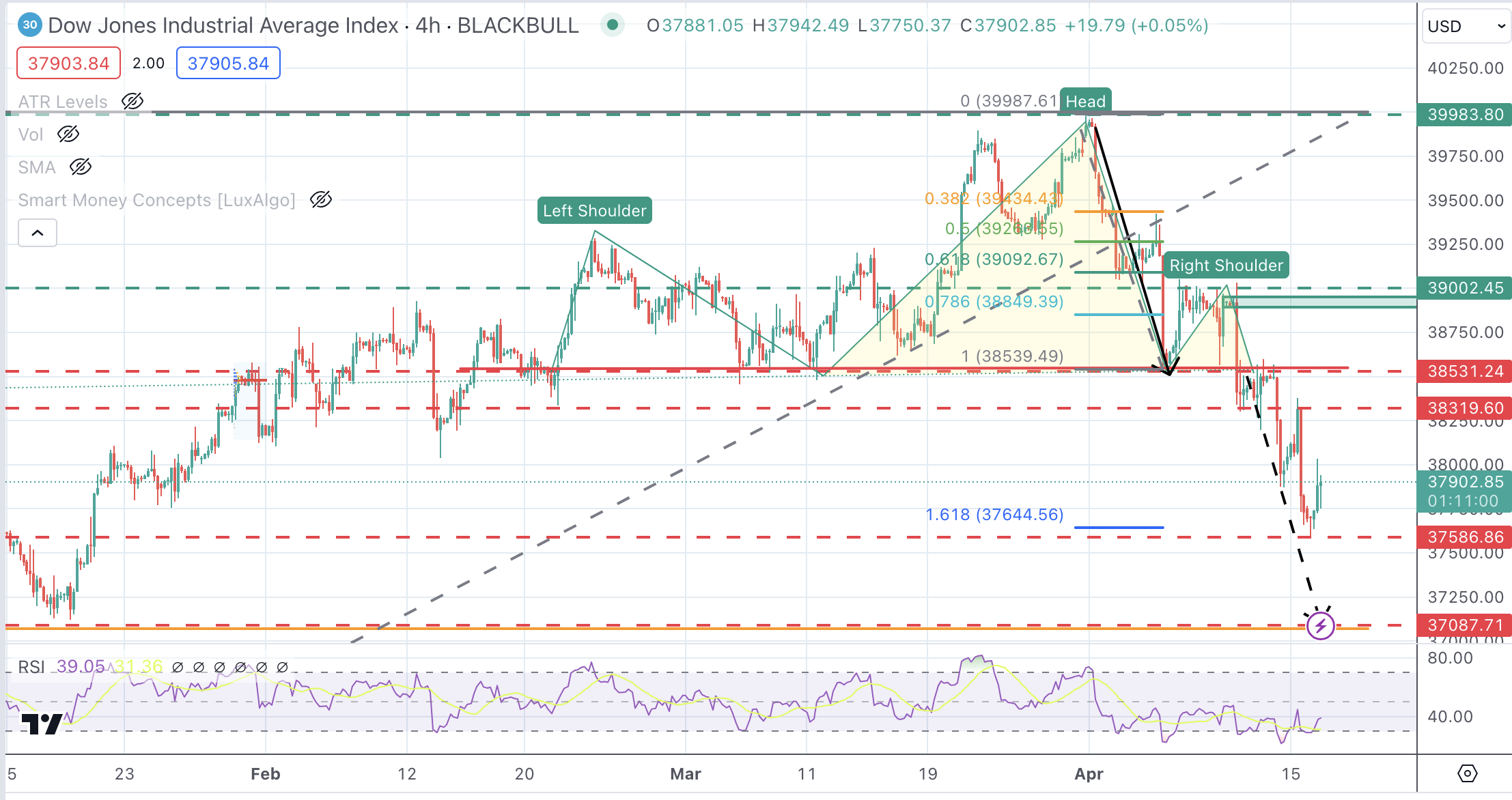- Analytics
- News and Tools
- Market News
- Dow Jones ticks up with geopolitical risks weighing on risk appetite
Dow Jones ticks up with geopolitical risks weighing on risk appetite
- Dow Jones index advanced moderately with geopolitical tensions limiting gains.
- Good quarterly earnings from United Health and Morgan Stanley provide optimism.
- Technical picture remains bearish with DJIA drifting away from March highs.
The Dow Jones Industrial Average (DJIA) is going through a moderate advance in a cautious session on Tuesday morning. The high US Treasury yields and market concerns about the volatile situation in the Middle East have offset the positive impact of quarterly earnings results.
United Health and Morgan Stanley have reported better-than-expected quarterly earnings on Tuesday, offsetting the disappointing results by Bank of America (BAC) and Johnson & Johnson (JNJ).
Traders, however, remain wary of risk as Israel ponders its response to Iran’s missile attack as the international community pressures its leaders to show restraint.
In this scenario, the main Wall Street indices are mixed, with the Dow Jones 0.4% higher to 37,897, while the S&P 500 and the NASDAQ are practically flat at 5,062 and 15,890, respectively.
Dow Jones news
The Health sector is leading gains for the second consecutive day with a 0.4% advance. That sector’s gains are followed by Technology, 0.3% higher. The Energy sector is the worst performer with a 1.08% decline, and next is the Utilities sector, down 0.95%.
UnitedHealth (UNH) is outperforming with a 6.2% rally to $473.43 after its quarterly report beat expectations. Salesforce (CRM) rises 2% to $278.45. On the negative side, Johnson & Johnson drops 2% to $144.67, and Apple (AAPL) loses another 1.7% to $169.78.
Dow Jones technical outlook
The DJIA index is trimming some loose ends on Tuesday although the overall picture remains bearish. The move below 38,560 has activated a Head & Shoulders pattern that points toward a sharper decline.
Immediate support is 37,586, followed by the measured target of the H&S pattern, which meets the mid-January low and 38.6% Fibonacci retracement at 37,087. A bullish reaction might find resistance at the 38,531 previous support ahead of the 39,000 region (order block).
Dow Jones Index 4-Hour Chart

Dow Jones FAQs
The Dow Jones Industrial Average, one of the oldest stock market indices in the world, is compiled of the 30 most traded stocks in the US. The index is price-weighted rather than weighted by capitalization. It is calculated by summing the prices of the constituent stocks and dividing them by a factor, currently 0.152. The index was founded by Charles Dow, who also founded the Wall Street Journal. In later years it has been criticized for not being broadly representative enough because it only tracks 30 conglomerates, unlike broader indices such as the S&P 500.
Many different factors drive the Dow Jones Industrial Average (DJIA). The aggregate performance of the component companies revealed in quarterly company earnings reports is the main one. US and global macroeconomic data also contributes as it impacts on investor sentiment. The level of interest rates, set by the Federal Reserve (Fed), also influences the DJIA as it affects the cost of credit, on which many corporations are heavily reliant. Therefore, inflation can be a major driver as well as other metrics which impact the Fed decisions.
Dow Theory is a method for identifying the primary trend of the stock market developed by Charles Dow. A key step is to compare the direction of the Dow Jones Industrial Average (DJIA) and the Dow Jones Transportation Average (DJTA) and only follow trends where both are moving in the same direction. Volume is a confirmatory criteria. The theory uses elements of peak and trough analysis. Dow’s theory posits three trend phases: accumulation, when smart money starts buying or selling; public participation, when the wider public joins in; and distribution, when the smart money exits.
There are a number of ways to trade the DJIA. One is to use ETFs which allow investors to trade the DJIA as a single security, rather than having to buy shares in all 30 constituent companies. A leading example is the SPDR Dow Jones Industrial Average ETF (DIA). DJIA futures contracts enable traders to speculate on the future value of the index and Options provide the right, but not the obligation, to buy or sell the index at a predetermined price in the future. Mutual funds enable investors to buy a share of a diversified portfolio of DJIA stocks thus providing exposure to the overall index.
© 2000-2024. All rights reserved.
This site is managed by Teletrade D.J. LLC 2351 LLC 2022 (Euro House, Richmond Hill Road, Kingstown, VC0100, St. Vincent and the Grenadines).
The information on this website is for informational purposes only and does not constitute any investment advice.
The company does not serve or provide services to customers who are residents of the US, Canada, Iran, The Democratic People's Republic of Korea, Yemen and FATF blacklisted countries.
Making transactions on financial markets with marginal financial instruments opens up wide possibilities and allows investors who are willing to take risks to earn high profits, carrying a potentially high risk of losses at the same time. Therefore you should responsibly approach the issue of choosing the appropriate investment strategy, taking the available resources into account, before starting trading.
Use of the information: full or partial use of materials from this website must always be referenced to TeleTrade as the source of information. Use of the materials on the Internet must be accompanied by a hyperlink to teletrade.org. Automatic import of materials and information from this website is prohibited.
Please contact our PR department if you have any questions or need assistance at pr@teletrade.global.















